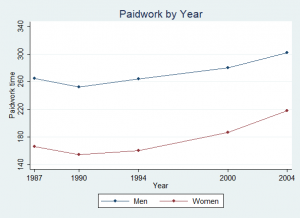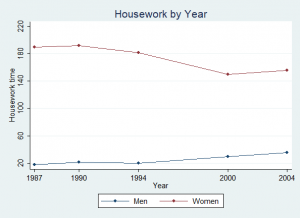The gender gap is said to be closing both in paid and unpaid work. Often, it means that women increase their participation in the labor market but decrease the time they spend on housework. Conversely, the gender gap in paid work is assumed to be closing because of the increase in labor participation among women but not among men, even if their overall participation might not be decreasing.
Interestingly, however, this is not true in all socio-economic and cultural contexts. For instance, using the time use data of the Taiwanese government, the following trend can be observed in the labor market participation among Taiwanese women and men (see Figure 1). Starting from the 1990s, both men’s and women’s work time has increased substantially. The trend reflects changes in the labor market structure when more opportunities became available for Taiwanese.

Figure 1. Paid Work Trends in Taiwan
On the other hand, Figure 2 also shows that trends in housework among Taiwanese were similar to those observed in the post-industrial societies. Women did less and less housework, whereas men steadily increased their participation.

Figure 2. Housework Trends in Taiwan
Cite as: Kolpashnikova, Kamila (2019). Taiwan: Paid and Unpaid Work Trends.
DATA: Taiwanese Time Use Survey (Academia Sinica, SRDA).